Why Winter Running Socks Matter
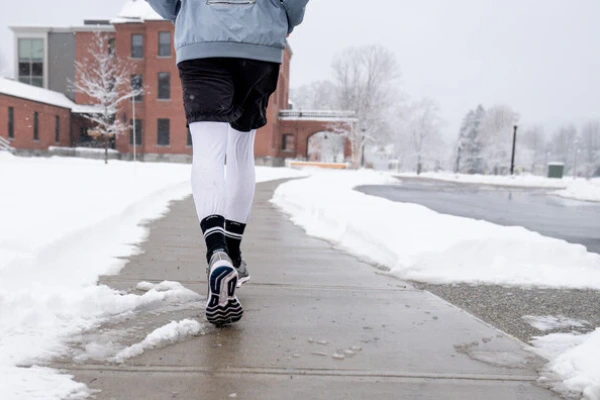
Running in winter is a unique challenge. Cold air bites at your skin, snow and slush soak your shoes, and numb toes can end a workout early. While most runners think about jackets, tights, or gloves, winter running socks are just as essential. They protect against the cold, manage moisture, and prevent blisters—keeping your feet warm and comfortable mile after mile.
This guide covers everything you need to know: how to match socks to your climate, what materials actually work, design differences for road vs. trail, and which models deliver the best performance at every budget.
Quick Picks: Best Winter Running Socks by Scenario
For runners who want fast answers, here’s a simple breakdown:
| Scenario | Best Choice | Why |
|---|---|---|
| Mild cold (cool, dry roads) | Merino blend crew socks | Warmth + breathability without bulk |
| Wet, slushy conditions | Waterproof running socks (Showers Pass, Sealskinz) | Block external moisture, keep feet dry |
| Extreme cold (sub-zero) | Over-the-calf merino or Drymax Cold Weather | Maximum insulation, shin wind protection |
| Budget-friendly | Synthetic crew packs | Affordable, durable, moisture-wicking |
| Premium | Merino compression or waterproof | Specialized warmth, durability, or circulation support |
How to Match Socks to Winter Conditions
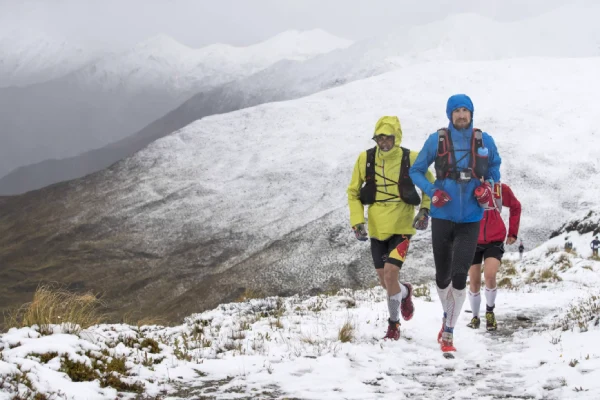
Mild Cold: Cool and Dry
When temperatures hover just above freezing, you don’t need thick socks. Merino-synthetic blends in crew length are ideal: they wick sweat away and keep your toes warm without overheating. Look for light to mid-cushion socks with mesh zones for ventilation.
Example: Smartwool Run Cold Weather Crew combines warmth with targeted breathability, making it versatile from autumn chills to light winter frost.
Wet and Slushy Runs
Running through slush or freezing rain is a recipe for soaked feet. Wet skin loses heat much faster, so waterproof running socks shine in these conditions. They sandwich a breathable membrane between knit layers to keep water out while allowing sweat to escape.
If you don’t want a membrane, consider socks made with hydrophobic fibers (like Drymax) that push sweat outward and insulate even when damp. Pairing them with water-resistant shoes adds an extra barrier.
Example: Showers Pass Crosspoint Waterproof Wool Crew keeps feet dry through puddles and wet snow while still feeling like a normal sock.
Extreme Cold: Sub-Zero Conditions
When the mercury plunges below freezing, warmth and coverage are critical. Choose over-the-calf winter running socks with heavy merino content or dual-layer synthetic designs. These traps warm air, protect against wind chill, and prevent gaps between tights and shoes.
Make sure your shoes have enough space; socks that are too thick can reduce circulation and make your toes colder. Some runners use a two-sock system (thin liner + wool outer) for added warmth, but only if there’s room to avoid blisters.
Example: Drymax Cold Weather Over-the-Calf adds an extra insulation panel along the shin, perfect for windy sub-zero runs.
Materials That Work for Cold Weather Running Socks and What to Avoid
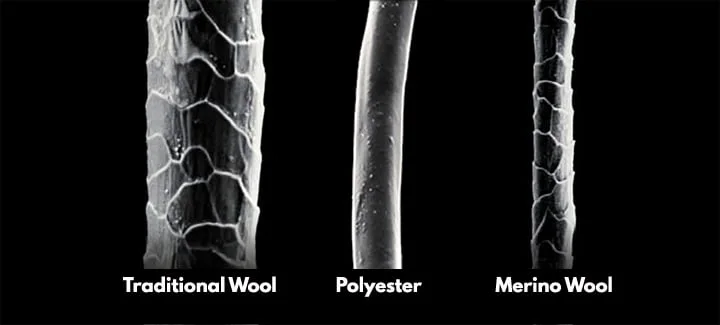
Merino Wool
Merino remains the gold standard for cold-weather running socks. Its ultrafine fibers trap heat even when damp, regulate temperature across a wide range, and naturally resist odor. Many runners note that merino socks can be worn on back-to-back runs without noticeable smell—something synthetics struggle with. However, pure merino is less durable, so the best winter running socks typically blend it with nylon or polyester for longer life.
(Want to explore other animal fibers like angora, alpaca, or standard sheep’s wool? Check out our detailed guide to wool types for a deeper dive.)
Synthetic Fibers
Polyester, nylon, and olefin (polypropylene) add strength and speed up drying. Olefin is especially valuable because it repels water completely, making it useful in slushy conditions. Feedback from trail runners shows synthetic-heavy blends stay lighter when soaked, though they can trap odor faster than wool-based socks.
Cotton (Avoid It)
Cotton is the one material you should skip. It absorbs sweat, dries slowly, and loses all insulating ability when wet. Many winter runners report cotton socks as the fastest route to cold, blister-prone feet.
The Best Formula
Most experts and product testers agree the sweet spot is a 50–70% merino wool blend, reinforced with nylon for strength and elastane for fit. This ratio balances warmth, moisture management, and durability. For example, Runner’s World noted that Smartwool’s and Darn Tough’s merino-nylon blends provided consistent comfort in both freezing road runs and snowy trails. Meanwhile, user reviews on long-distance forums emphasize that these blends outlast pure wool socks while still resisting odor across multiple runs.
Road vs. Trail: Key Differences in Winter
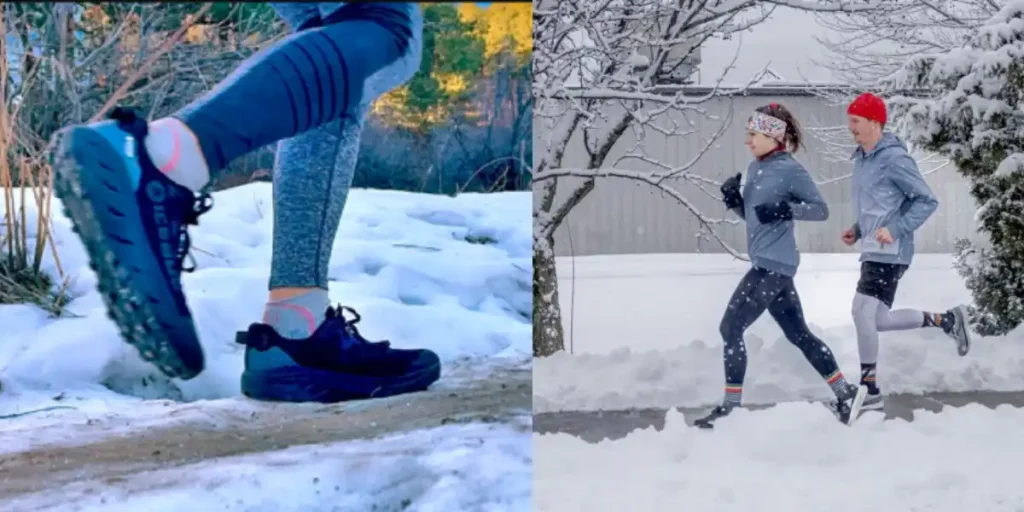
Winter surfaces amplify the differences between road and trail running, and your socks should adapt accordingly.
- Road running socks
Road shoes fit more snugly, so socks here are typically lighter and thinner, with targeted cushioning in the heel and forefoot to soften the repetitive strike on pavement. In winter, a crew length is best, covering the ankles and sealing the gap between shoes and tights to keep out cold air. - Trail running socks
Trails in winter bring mud, snow, and debris. Trail-specific socks usually have taller cuffs (crew or over-the-calf) to block grit and snow, plus denser, more durable knits to withstand abrasion. Many also feature compression bands or a snugger fit to prevent slipping when you’re navigating uneven ground.
Practical tip: If you split time between roads and trails, it’s smart to keep at least one style of each in your rotation. The extra coverage of a trail sock can even double as added warmth on bitter road runs.
Features That Prevent Blisters and Cold Toes
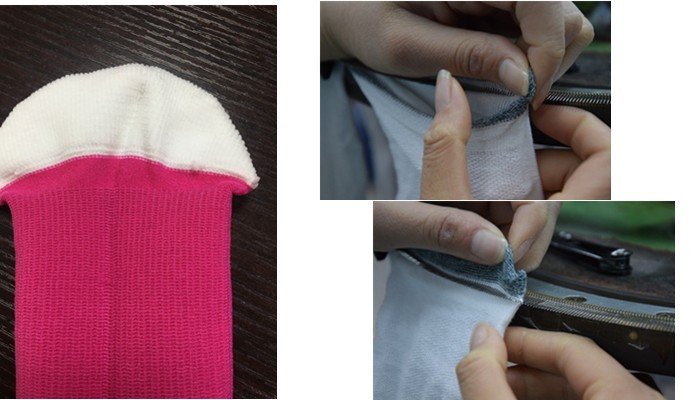
The right winter running socks do more than add warmth—they also minimize friction, stabilize your foot, and manage sweat. Here are the design elements to look for:
- Seamless toes: A smooth, flat-knit toe box eliminates pressure points and reduces the risk of painful blisters during long runs.
- Arch support bands: Gentle compression around the midfoot keeps the sock locked in place, cutting down on slippage and easing fatigue in the arch.
- Targeted cushioning: Extra padding in high-impact zones like the heel and toe improves shock absorption, adds insulation, and helps protect against cold ground contact.
- Breathable mesh zones: Ventilation panels on the top of the foot let heat and moisture escape, keeping feet drier and more comfortable in cold-weather miles.
- Secure cuffs: A snug, stay-put cuff prevents the sock from sliding down and blocks snow or grit from creeping inside your shoe.
For runners who are especially prone to toe blisters, toe socks (such as Injinji) are worth considering. By wrapping each toe individually, they eliminate skin-on-skin rubbing and allow for better moisture control between the toes.
Choosing Cold Weather Running Socks by Budget Tier
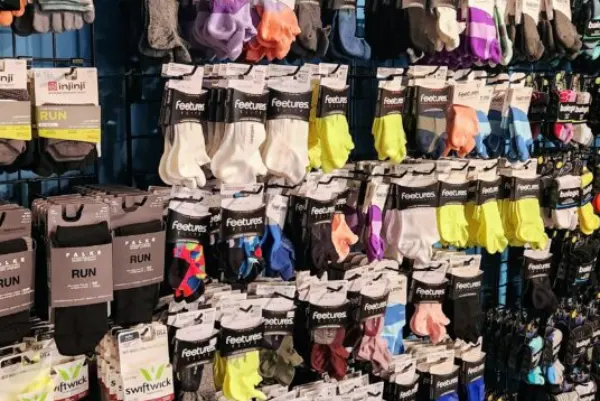
When evaluating winter running socks, it helps to think in tiers rather than exact prices. Each tier aligns with different materials, design priorities, and target users. From a buyer’s or retailer’s perspective, this framework clarifies which category serves which audience best.
Entry-Level Tier
At the most affordable tier, socks are usually made from synthetic fibers such as polyester or nylon. These materials are durable, quick-drying, and easy to produce at scale.
- Design priorities: Simple crew height, moderate cushioning, reinforced toe and heel for longevity.
- Target audience: High-volume runners, teams, or training groups seeking basic cold-weather coverage in mild conditions or indoor winter sessions. Cost efficiency is the main driver, but warmth and odor control are limited.
Mid-Tier
The middle tier introduces merino wool blends combined with nylon or polyester. This is where performance and value intersect: merino contributes warmth, softness, and odor resistance, while synthetics provide structural strength and elasticity.
- Design priorities: Seamless toe construction to prevent blisters, targeted compression bands for support, and light-to-medium cushioning.
- Target audience: Recreational to competitive runners who want reliable performance in cold-weather road and trail running. Also suitable for clubs, retailers, or brands looking to offer versatile products that balance comfort, performance, and price appeal.
Premium Tier
At the premium end, socks are engineered for specialized performance needs. This includes merino-rich blends with higher density, waterproof membranes for wet environments, or compression technologies for circulation and recovery. These socks are designed not only for warmth but also for specific scenarios such as slushy roads, sub-zero trails, or endurance events.
- Design priorities: Over-the-calf coverage for maximum insulation, hydrophobic or waterproof layers, anatomical shaping, and in some cases, graduated compression.
- Target audience: Endurance athletes, professional teams, and outdoor-focused retailers catering to demanding winter conditions. This tier suits customers who prioritize performance, protection, and long-term durability over cost efficiency.
FAQs About Winter Running Socks
What are the best cold-weather socks for running?
The best winter running socks use merino wool blends for warmth and odor resistance, with added nylon for durability. For wet or slushy runs, waterproof running socks with breathable membranes keep feet dry. Over-the-calf styles provide extra insulation and wind protection in sub-zero conditions, ensuring comfort on long winter miles.
Are merino socks good for winter running?
Yes, merino running socks are ideal for winter. Merino wool regulates temperature, insulates when damp, and naturally resists odor. Blended with nylon or polyester, they last longer and maintain shape. Choose light to mid-cushion merino socks for mild cold, or heavier, over-the-calf versions for extreme winter conditions.
Do waterproof running socks really work?
Waterproof running socks are highly effective in slush, snow, or freezing rain. They use a breathable membrane between knit layers to block external moisture while letting sweat escape. Although warmer than standard socks, they keep feet dry and warmer than traditional fabrics, making them invaluable in consistently wet winter climates.
Should I wear two pairs of socks for winter running?
Layering socks can help in sub-zero weather if your shoes have room. A thin synthetic liner wicks sweat, while a merino outer layer insulates. However, wrinkles or tight fits increase blister risk. For most runners, a single pair of well-designed cold-weather running socks is more effective.
What sock height is best for winter running?
Crew socks are the most versatile for cold-weather running, covering the ankles to block drafts. For snowy or sub-zero conditions, over-the-calf socks provide extra insulation and eliminate gaps with tights. Ankle socks are less effective in winter, as they leave skin exposed to cold air and moisture.
Conclusion
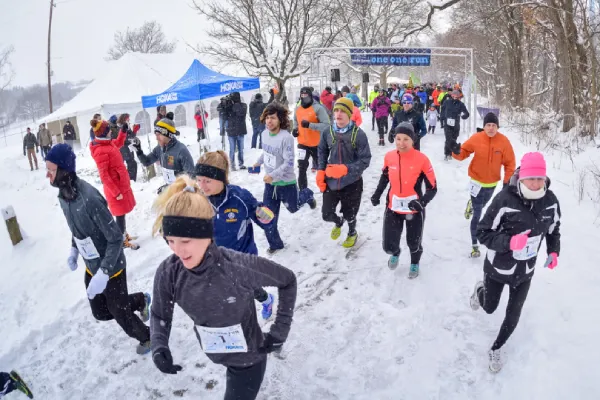
The right pair of winter running socks can transform cold-weather training—from miserable miles with frozen toes to comfortable runs where you barely notice the conditions. By matching sock materials and designs to your climate, investing in the right length and fit, and caring for them properly, you’ll keep your feet warm, dry, and blister-free all winter long.
For individual runners, it’s about comfort and performance. For brands and distributors, it’s also about value. If you’re a business looking to expand your winter running gear lineup, get in touch with us today to request samples of Max Hosiery high-performance winter running socks—and experience firsthand how the right design can deliver both customer satisfaction and lasting loyalty.
